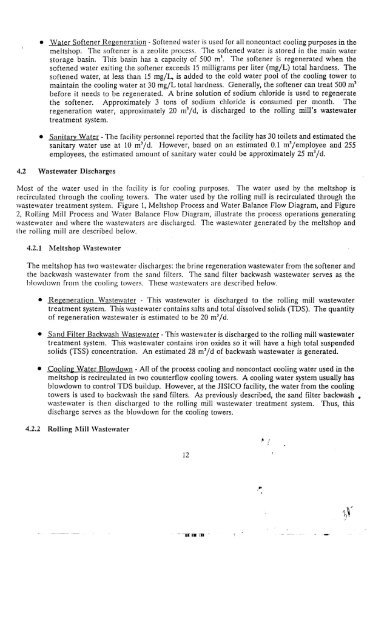Watcr Q!!alit\1 lmprovcmct1t at1() COf1scrvatiof1l'rojcct
Watcr Q!!alit\1 lmprovcmct1t at1() COf1scrvatiof1l'rojcct
Watcr Q!!alit\1 lmprovcmct1t at1() COf1scrvatiof1l'rojcct
You also want an ePaper? Increase the reach of your titles
YUMPU automatically turns print PDFs into web optimized ePapers that Google loves.
• \Vater Softener Regeneration - Softened water is used for all noncontact cooling purposes in the<br />
meltshop. TIle softener is a zeolite proccss. TIle softened water is stored in the main water<br />
storage basin. TIlis basin has a capacity of 500 m J • TIle softener is regenerated when the<br />
softened water exiting the softener exceeds 15 milligrams per liter (mgjL) total hardness. The<br />
softened water, at less than 15 mgjL, is added to the cold water pool of the cooling tower to<br />
maintain the cooling water at 30 mgjL total hardness. Generally, the softener can treat 500 m 3<br />
before it needs to be regenerated. A brine solution of sodium chloride is used to regenerate<br />
the softener. Approximately 3 tons of sodium chloride is consumed per month. The<br />
regeneration water, approximately 20 m 3 jd, is discharged to the rolling mill's wastewater<br />
treatment system.<br />
• Sanitary Water -TIle facility personnel reported that the facility has 30 toilets and estimated the<br />
sanitary water use at 10 mJjd. However, based on an estimated 0.1 mJjemployee and 255<br />
employees, the estimated amount of sanitary water could be approximately 25 m J jd.<br />
4.2 Wastewater Discharges<br />
Most of the water used in thc facility is for cooling purposes. TIle water used by the meltshop is<br />
recirculated through the cooling towers. 11le water used by the rolling mill is recirculated through the<br />
wastewater treatment system. Figure 1, Meltshop Process and Water Balance Flow Diagram, and Figure<br />
2, Rolling Mill Process and Water Balance Flow Diagram, illustrate the process operations generating<br />
wastewater and where the wastewaters are discharged. TIle wastewater generated by the meltshop and<br />
the rolling mill are described below.<br />
4.2.1 Meltshop \Vastewater<br />
The meltshop has two wastewater discharges: the brine regeneration wastewater from the softener and<br />
the backwash wastewater from the sand filters. TIle sand filter backwash wastewater serves as the<br />
hlowdown frolll the cooling towcrs. Thcse wastcwaters are described below.<br />
• Regeneration Wastewater - This wastewater is discharged to the rolling mill wastewater<br />
treatment system. 111is wastewater contains salts and total dissolved solids (TDS). The quantity<br />
of regeneration wastewater is estimated to be 20 m J jd.<br />
• Sand Filter Backwash Wastewater - This wastewater is discharged to the rolling mill wastewater<br />
treatment system. This wastewater contains iron oxides so it will have a high total suspended<br />
solids (TSS) concentration. An estimated 28 m 3 jd of backwash wastewater is generated.<br />
• Cooling Water B1owdown - All of the process cooling and noncontact cooling water used in the<br />
meltshop is recirculated in two counterflow cooling towers. A cooling water system usually has<br />
blowdown to control TDS buildup. However, at the JISICO facility, the water from the cooling<br />
towers is used to backwash the sand filters. As previously described, the sand filter backwash •<br />
wastewater is then discharged to the rolling mill wastewater treatment system. Thus, this<br />
discharge serves as the blowdown for the cooling towers.<br />
4.2.2 Rolling Mill Wastewater<br />
12<br />
." :<br />
! ••

















